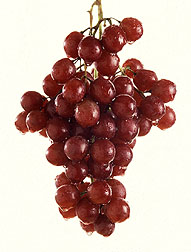|

Click image for caption and other photo information.
|
Another Grape Compound Shows Promise as Cancer-Preventing Agent
By Luis Pons
May 17, 2002
A second compound in grapes has been found to have properties that give it promise as a cancer-preventing agent, according to an Agricultural Research Service study.
That finding by ARS research chemist Agnes Rimando, at the agency’s Natural Products Utilization Research Unit at Oxford, Miss., is part of a study posted on the Journal of Agricultural and Food Chemistry’s web site. ARS is the chief scientific research agency of the U.S. Department of Agriculture.
In the study, Rimando reports that a compound called pterostilbene (terro-STILL-bien) possesses similar cancer chemopreventive qualities to those found in resveratrol, another compound in grapes. Pterostilbene also showed strong inhibitory activity against breast cancer cell lines. But the evidence remains preliminary and the compound has yet to be evaluated in humans, according to Rimando.
In previous research, resveratrol has been credited with helping grape plants fight off fungi and has been linked to low incidences of coronary heart disease among wine- drinking populations.
Unlike resveratrol, however, pterostilbene is already known to posses anti-diabetic properties. It was first isolated from red sandalwood (Pterocarpus santalinus). Together with resveratrol, it has also been identified in Vitis vinifera (wine grape) leaves, in Chardonnay and Gamay berries infected with fungus, and in healthy Pinot Noir and Gamay berries.
The study, prompted by pterostilbene's close structural similarity to resveratrol, was conducted with the use of a mouse mammary gland culture model that was exposed to a chemical carcinogen. The carcinogen caused precancerous cells on which the compound was tested. The mouse mammary gland test was performed by Rimando’s collaborators at the University of Illinois at Chicago.
Rimando conducted the study with five other scientists, including plant physiologist Stephen O. Duke, the Natural Products Utilization Research Unit's research leader, and John M. Pezzuto and Rajendra Mehta at the University of Illinois at Chicago. The study was funded by USDA, the University of Illinois at Chicago and the National Cancer Institute.
|

